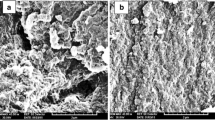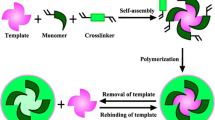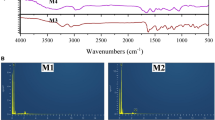Abstract
In this paper, we reported a rapid and simple approach to synthesize molecularly imprinted polymers (MIPs) materials for sensing of 2,4-dichlorophenoxyacetic acid (2,4-D) residues in environmental water and mixed juice. Initially, MIPs materials were prepared via visible light-initiated reversible addition-fragmentation chain transfer (RAFT) emulsion polymerization at ambient temperature using 2,4-D and its analogs as template molecules, in which 4-vinyl pyridine (4-VP), ethylene glycol dimethacrylate (EGDMA), (2,4,6-trimethylbenzoyl) diphenylphosphine oxide (TPO), 2-(((dodecylthio)carbonothioyl)thio)-2-methylpropanoic acid (DDMAT) were functional monomer, cross-linker, visible light initiator and RAFT agent, respectively. Then, the morphologies of the MIPs materials were characterized by FT-IR, SEM and DLS. The results showed that the MIPs materials were well-distributed spherical particles with sizes ranging from 1 to 2 μm. Furthermore, a four-channel MIPs sensor array included four polymer microspheres with a fluorescent dye displacement procedure was developed to distinguish the templates and their chemical analogs at the ppm concentration level. With the support of principal component analysis and hierarchical cluster analysis, the four-channel MIPs sensor array proves to be a simple and effective method to recognize and distinguish the templates and nontemplates in aqueous solution with 100% accuracy. Finally, the four-channel MIPs sensor array was also found to have satisfactory accuracy in monitoring 2,4-D contaminated environmental water and mixed juice.










Similar content being viewed by others
References
Zhang HQ (2020) Molecularly imprinted nanoparticles for biomedical applications. Adv Mater 32:1806328
Madikizela LM, Tavengwa NT, Chimuka L (2018) Applications of molecularly imprinted polymers for solid-phase extraction of non-steroidal anti-inflammatory drugs and analgesics from environmental waters and biological samples. J Pharm Biomed 147:624–633
Rutkowska M, Plotka-Wasylka J, Morrison C, Wieczorek PP, Namiesnik J, Marc M (2018) Application of molecularly imprinted polymers in analytical chiral separations and analysis. TRAC-Trend Anal Chem 102:91–102
Huang SY, Xu JQ, Zheng JT, Zhu F, Xie LJ, Ouyang GF (2018) Synthesis and application of magnetic molecularly imprinted polymers in sample preparation. Anal Bioanal Chem 410:3991–4014
Chen CC, Luo JX, Li CL, Ma MF, Yu WB, Shen YJ, Wang ZH (2018) Molecularly imprinted polymer as an antibody substitution in pseudo-immunoassays for chemical contaminants in food and environmental samples. J Agric Food Chem 66:2561–2571
Boulanouar S, Mezzache S, Combes A, Pichon V (2018) Molecularly imprinted polymers for the determination of organophosphorus pesticides in complex samples. Talanta 176:465–478
Speltini A, Scalabrini A, Maraschi F, Sturini M, Profumo A (2017) Newest applications of molecularly imprinted polymers for extraction of contaminants from environmental and food matrices: a review. Anal Chim Acta 974:1–26
Ansari S, Karimi M (2017) Recent configurations and progressive uses of magnetic molecularly imprinted polymers for drug analysis. Talanta 167:470–485
Pan JM, Chen W, Ma Y, Pan GQ (2018) Molecularly imprinted polymers as receptor mimics for selective cell recognition. Chem Soc Rev 47:5574–5587
Gui RJ, Jin H, Guo HJ, Wang ZH (2018) Recent advances and future prospects in molecularly imprinted polymers-based electrochemical biosensors. Biosens Bioelectron 100:56–70
Dabrowski M, Lach P, Cieplak M, Kutner W (2018) Nanostructured molecularly imprinted polymers for protein chemosensing. Biosens Bioelectron 102:17–26
Zamora-Galvez A, Morales-Narvaez E, Mayorga-Martinez CC, Merkoci A (2017) Nanomaterials connected to antibodies and molecularly imprinted polymers as bio/receptors for bio/sensor applications. Appl Mater Today 9:387–401
Yanez-Sedeno P, Campuzano S, Pingarron JM (2017) Electrochemical sensors based on magnetic molecularly imprinted polymers: a review. Anal Chim Acta 960:1–17
Malitesta C, Di Masi S, Mazzotta E (2017) From electrochemical biosensors to biomimetic sensors based on molecularly imprinted polymers in environmental determination of heavy metals. Front Chem 5:47
Greene NT, Shimizu KD (2005) Colorimetric molecularly imprinted polymer sensor array using dye displacement. J Am Chem Soc 127:5695–5700
Greene NT, Morgan SL, Shimizu KD (2004) Molecularly imprinted polymer sensor arrays. Chem Commun. https://doi.org/10.1039/B401677G
Xu D, Zhu W, Wang C, Wang C, Tian T, Li J, Lan Y, Zhang GX, Zhang DQ, Li GT (2014) Label-free detection and discrimination of poly-brominated diphenylethers using molecularly imprinted photonic cross-reactive sensor arrays. Chem Commun 50:14133–14136
Podrazka M, Baczynska E, Kundys M, Jelen PS, Nery EW (2018) Electronic tongue-a tool for all tastes? Biosensors 8:3
Lai EPC, Fafara A, VanderNoot VA, Kono M, Polsky B (1998) Surface plasmon resonance sensors using molecularly imprinted polymers for sorbent assay of theophylline, caffeine, and xanthine. Can J Chem 76:265–273
Shimizu KD, Stephenson CJ (2010) Molecularly imprinted polymer sensor arrays. Curr Opin Chem Biol 14:743–750
Huynh TP, Kutner W (2015) Molecularly imprinted polymers as recognition materials for electronic tongues. Biosens Bioelectron 74:856–864
Wei XB, Zhang ZR, Zhang LF, Xu XH (2019) Synthesis of molecularly imprinted polymers/NiCo2O4 nanoneedle arrays on 3D graphene electrode for determination of sulfadimidine residue in food. J Mater Sci 54:2066–2078. https://doi.org/10.1007/s10853-018-2975-z
Lieberzeit PA, Dickert FL (2009) Chemosensors in environmental monitoring: challenges in ruggedness and selectivity. Anal Bioanal Chem 393:467–472
Herrera-Chacon A, Gonzalez-Calabuig A, Campos I, del Valle M (2018) Bioelectronic tongue using MIP sensors for the resolution of volatile phenolic compounds. Sens Actuator B Chem 258:665–671
Lu WL, Dong X, Qiu LL, Yan ZQ, Meng ZH, Xue M, He X, Liu XY (2017) Colorimetric sensor arrays based on pattern recognition for the detection of nitroaromatic molecules. J Hazard Mater 326:130–137
Chunta S, Suedee R, Singsanan S, Lieberzeit PA (2019) Sensing array based on molecularly imprinted polymers for simultaneous assessment of lipoproteins. Sens Actuator B Chem 298:126828
Liu CJ, Shang L, Yoshioka HT, Chen B, Hayashi K (2018) Preparation of molecularly imprinted polymer nanobeads for selective sensing of carboxylic acid vapors. Anal Chim Acta 1010:1–10
Jasinski F, Zetterlund PB, Braun AM, Chemtob A (2018) Photopolymerization in dispersed systems. Prog Polym Sci 84:47–88
Chen M, Zhong MJ, Johnson JA (2016) Light-controlled radical polymerization: mechanisms, methods, and applications. Chem Rev 116:10167–10211
Kaastrup K, Sikes HD (2016) Using photo-initiated polymerization reactions to detect molecular recognition. Chem Soc Rev 45:532–545
Pan XC, Tasdelen MA, Laun J, Junkers T, Yagci Y, Matyjaszewski K (2016) Photomediated controlled radical polymerization. Prog Polym Sci 62:73–125
Ma YJ, Gao P, Ding Y, Huang LL, Wang L, Lu XH, Cai YL (2019) Visible light initiated thermoresponsive aqueous dispersion polymerization-induced self-assembly. Macromolecules 52:1033–1041
Huang LL, Ding Y, Ma YJ, Wang L, Liu QZ, Lu XH, Cai YL (2019) Colloidal stable PIC vesicles and lamellae enabled by wavelength-orthogonal disulfide exchange and polymerization-induced electrostatic self-assembly. Macromolecules 52:4703–4712
Zhu QK, Li XM, Xiao YH, Xiong Y, Wang SP, Xu CL, Zhang J, Wu XW (2017) Synthesis of molecularly imprinted polymer via visible light activated raft polymerization in aqueous media at room temperature for highly selective electrochemical assay of glucose. Macromol Chem Phys 218:201700141
Islam F, Wang J, Farooq MA, Khan MSS, Xu L, Zhu JW, Zhao M, Muñose S, Li QX, Zhou WJ (2018) Potential impact of the herbicide 2,4-dichlorophenoxyacetic acid on human and ecosystems. Environ Int 111:332–351
Ye M, Beach J, Martin JW, Senthilselvan A (2017) Pesticide exposures and respiratory health in general populations. J Environ Sci 51:361–370
Farka Z, Juřík T, Kovář D, Trnková L, Skládal P (2017) Nanoparticle-based immunochemical biosensors and assays: recent advances and challenges. Chem Rev 117:9973–10042
Pereira I, Rodrigues MF, AaR Chaves, Vaz BG (2018) Molecularly imprinted polymer (MIP) membrane assisted direct spray ionization mass spectrometry for agrochemicals screening in foodstuffs. Talanta 178:507–514
Liang YM, Yu LL, Yang R, Li X, Qu LB, Li JJ (2017) High sensitive and selective graphene oxide/molecularly imprinted polymer electrochemical sensor for 2,4-dichlorophenol in water. Sens Actuator B Chem 240:1330–1335
Xu Z, Deng P, Li J, Tang S, Cui Y (2019) Modification of mesoporous silica with molecular imprinting technology: a facile strategy for achieving rapid and specific adsorption. Mater Sci Eng, C 94:684–693
Yang X, Chen J, Liu H, Li XF, Zhong SA (2019) Molecularly imprinted polymers based on zeolite imidazolate framework-8 for selective removal of 2,4-dichlorophenoxyacetic acid. Colloid Surf A 570:244–250
Hua MZ, Feng SL, Wang S, Lu XN (2018) Rapid detection and quantification of 2,4-dichlorophenoxyacetic acid in milk using molecularly imprinted polymers-surface-enhanced Raman spectroscopy. Food Chem 258:254–259
Wang J, Xu Q, Xia WW, Shu Y, Jin DQ, Zang Y, Hu XY (2018) High sensitive visible light photoelectrochemical sensor based on in situ prepared flexible Sn3O4 nanosheets and molecularly imprinted polymers. Sens Actuators B Chem 271:215–224
Wang H, Xu Q, Wang J, Du W, Liu F, Hu X (2018) Dendrimer-like amino-functionalized hierarchical porous silica nanoparticle: a host material for 2,4-dichlorophenoxyacetic acid imprinting and sensing. Biosens Bioelectron 100:105–114
Wagner S, Jrm Bell, Biyikal M, Gawlitza K, Rurack K (2018) Integrating fluorescent molecularly imprinted polymer (MIP) sensor particles with a modular microfluidic platform for nanomolar small-molecule detection directly in aqueous samples. Biosens Bioelectron 99:244–250
Ruiz-Córdova GA, Khan S, Gonçalves LM, Pividori MI, Picasso G, Sotomayor MDPT (2018) Electrochemical sensing using magnetic molecularly imprinted polymer particles previously captured by a magneto-sensor. Talanta 181:19–23
Liu Y, Hu X, Meng MJ, Liu ZC, Ni L, Meng XG, Qiu J (2016) RAFT-mediated microemulsion polymerization to synthesize a novel high-performance graphene oxide-based cadmium imprinted polymer. Chem Eng J 302:609–618
Chowdhury S, Balasubramanian R (2014) Recent advances in the use of graphene-family nanoadsorbents for removal of toxic pollutants from wastewater. Adv Colloid Interface 204:35–56
Wang L, Frei MS, Salim A, Johnsson K (2019) Small-molecule fluorescent probes for live-cell super-resolution microscopy. J Am Chem Soc 141:2770–2781
Mako TL, Racicot JM, Levine M (2019) Supramolecular luminescent sensors. Chem Rev 119:322–477
Ma YF, Li YW, Ma K, Wang Z (2018) Optical colorimetric sensor arrays for chemical and biological analysis. Sci China Chem 61:643–655
Bigdeli A, Ghasemi F, Golmohammadi H, Samira Abbasi-Moayed S, Nejad MAF, Fahimi-Kashani N, Jafarinejad S, Shahrajabian M, Hormozi-Nezhad MR (2017) Nanoparticle-based optical sensor arrays. Nanoscale 9:16546–16563
Peveler WJ, Yazdani M, Rotello VM (2016) Selectivity and specificity: pros and cons in sensing. ACS Sens 1:1282–1285
Johnson KJ, Rose-Pehrsson SL (2015) Sensor array design for complex sensing tasks. Annu Rev Anal Chem 8:287–310
Askim JR, Mahmoudi M, Suslick KS (2013) Optical sensor arrays for chemical sensing: the optoelectronic nose. Chem Soc Rev 42:8649–8682
Liu Y, Ding LP, Cao Y, Fang Y (2012) Fluorescent sensor arrays. Prog Chem 24:1915–1927
Acknowledgements
This work was supported by the Scientific Research Fund of Hunan Provincial Education Department (19K086), the Natural Science Foundation of Hunan Province (2006JJ6148) and the Hunan 2011 Collaborative Innovation Center of Chemical Engineering & Technology with Environmental Benignity and Effective Resource Utilization.
Author information
Authors and Affiliations
Corresponding authors
Ethics declarations
Conflict of interest
The authors declare no conflict of interest.
Additional information
Publisher's Note
Springer Nature remains neutral with regard to jurisdictional claims in published maps and institutional affiliations.
Rights and permissions
About this article
Cite this article
Wu, X., Jiao, T., Xu, C. et al. Preparation of molecularly imprinted polymers for sensing of 2,4-dichlorophenoxyacetic acid residues in environmental water and mixed juice. J Mater Sci 55, 6848–6860 (2020). https://doi.org/10.1007/s10853-020-04516-7
Received:
Accepted:
Published:
Issue Date:
DOI: https://doi.org/10.1007/s10853-020-04516-7




